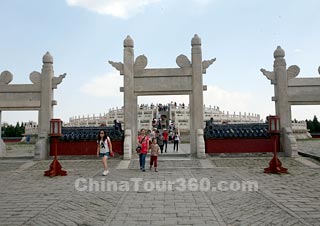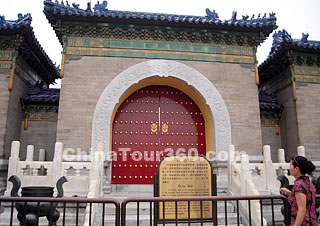As a key complex in the southern part of the Temple of Heaven, the architectural complex known as the Circular Mound Altar is centered on the Circular Mound Altar itself, which was used for offering sacrifices to the heaven. It also includes auxiliary buildings such as the Zhaoheng Gate, Tall and Erect Cloud Gate, South Divine Kitchen, Imperial Vault of Heaven and Chengzhen Gate. The whole complex was built with complete sacrificial facilities, demonstrating the royal family’s great attention to the sacrificial ceremony to heaven.
|
|
The Zhaoheng Gate is the South Heaven Gate of the Circular Mound Altar. Originally, it was actually the south gate of the Circular Mound Altar, but its southern outer wall was destroyed many years ago. It also serves as the southern starting point of the north-south axis of the Temple of Heaven, which means tourists step into a key area of the Temple of Heaven as soon as they cross the gate.
Entering the Zhaoheng Gate, visitors see an avenue of white marble running straight to the Circular Mound Altar which is surrounded by a two-layer wall. The inner wall is round while the outer wall is square, which is derived from the ancient Chinese saying “heaven is round and the earth is square.” The central part of four sides of both the inner and outer wall was built with three Lingxing Gates of different sizes. To sum them up, there are 24 Lingxing Gates in total, which were together named ‘Tall and Erect Cloud Gate’.
The Circular Mound Altar, built in 1530, is an open-air round altar with three tiers. It was the place where the emperors held the sacrificial ceremony to heaven on the Winter Solstice. The sacrifice to heaven was the most significant among all the sacrifices for the royal family. It was even more imprtant than the sacrifice to the ancestors.
Both the Circular Mound Altar and the Altar of Prayer for Good Harvests have a Divine Kitchen, a Holy Storehouse and a Butcher Pavilion. The Divine Kitchen was used to make various offerings. The Holy Storehouse was for storing the offerings. The Butcher Pavilion was where the sacrificial animals were slaughtered. The three buildings together were called the Courtyard of Divine Kitchen. The one located in the southern part of the Temple of Heaven was named the South Courtyard of the Divine Kitchen. Being consistent with the open-air sacrificial ceremony, the buildings here are more open than the North Divine Kitchen in the Altar of Prayer for Good Harvests.
The Imperial Vault of Heaven is to the north of the Circular Mound Altar. It is situated on a Xumi Base (the pedestal or base of a Buddhist tower or temple) of 3 meters (9.8 feet) high. It was the place where the tablet of God of Heaven and the tablets of the emperors' ancestors were worshipped. The courtyard wall of the Imperial Vault of Heaven is the famous Echo Wall which is a well-preserved ancient building.
The Chengzhen (means the obtainment of hopes) Gate is a tall brick gate just north of the Architectural Complex of the Circular Mound Altar. The gate is red and has three doorways. It is one of the four gates in the Circular Mound Altar. It is also the boundary between the Circular Mound Altar and the Altar of Prayer for Good Harvests.
![]() Go to the Next Attraction: Imperial Vault of Heaven
Go to the Next Attraction: Imperial Vault of Heaven










